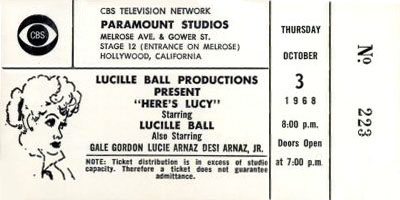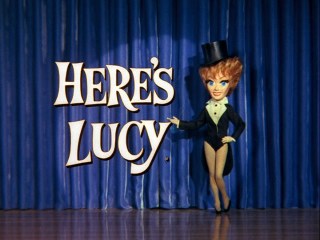Here’s Lucy


Lucille Ball’s third sitcom, Here’s Lucy, debuted on September 23, 1968, a full six months after her previous series, The Lucy Show, had left the network. One might wonder why the change since her new character, Lucy Carter, wasn’t all that different from her character on The Lucy Show, Lucy Carmichael, and both had Gale Gordon playing the “foil” in her life. Mr. Gordon’s character didn’t change a lot, either, nor did the show’s Monday night time slot. Depending on who you asked, you could get any number of reasons for the conversion…
The old format was tired. After 156 episodes, Lucy needed some sort of change in her show, however minor.
Lucy wanted to work with her kids, Lucie and Desi Jr. Rather than find an awkward way to insert those characters into the life of Lucy Carmichael (which would mean they would not play her children), it was easier to change Lucy to Lucy Carter and just make them that character’s offspring.
Starting a new show would mean that the old show would be freed up for unrestricted syndication and money could be made off those 156 episodes.
Lucy had owned The Lucy Show by virtue of her ownership of Desilu Studios, the company that produced it. In 1967, she sold Desilu to Gulf+Western, the conglomerate which the year before had acquired Paramount Pictures. Lucy didn’t want to keep doing a TV show in which she had no ownership position so she ended The Lucy Show and started a new show which could be owned by her new company, which was co-owned by Gary Morton. Here’s Lucy was produced by Lucille Ball Productions.
And there may have been other reasons as well, but all of the above were probably valid to some extent. How was the new show? About the same as the old show. It had memorable times, like the 1970 episode which guested Elizabeth Taylor and Richard Burton. It had poorer moments, like most of the 1972-1973 season wherein Lucy Carter was in a wheelchair owing to the real Lucy’s leg fracture from a skiing accident. Ms. Ball’s physical comedy was scaled back after that, even after the cast was removed. (They probably would have had to do that even if she hadn’t fractured her leg. Lucy was 61 years old in 1972, a bit aged to be doing some of the things she’d been doing…including skiing when she wasn’t performing.)

Even though Lucy no longer owned the place, Here’s Lucy filmed on the Paramount lot, and the filmings were said to be a love fest to her, with Lucy-loving audiences. Gary Morton often did the warm-ups and gave her the full star treatment, and guest stars abounded. All of Lucy’s old pals — Jack Benny, George Burns, Milton Berle, Phil Silvers, Carol Burnett, et al (even Vivian Vance) — dropped by one or more times. In addition to her kids and Gordon, she was joined in the cast by Mary Jane Croft, who filled Vance’s old function of playing Lucy’s best friend.
The show had good ratings throughout its run and its cancellation (the last one aired March 18, 1974) was met with some controversy. Prime-time TV, especially on CBS, had changed with the coming of shows like All in the Family, M*A*S*H and The Mary Tyler Moore Show, and others that were believed to attract a younger, hipper viewership. Lucy’s act, which hadn’t changed much since the days of I Love Lucy, didn’t seem to fit in. Her “retirement” from weekly television after nearly 23 years was announced as her idea but it was rumored that CBS had the idea first, and that an attempt to place the series with another network had failed. Lucy went on to do guest appearances and specials and even made one return to the world of the weekly sitcom — Life With Lucy in 1986.






